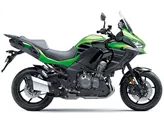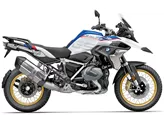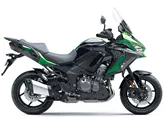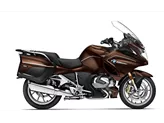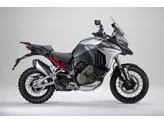BMW R 1200 GS 2015 vs. Kawasaki Versys 1000 2016

BMW R 1200 GS 2015

Kawasaki Versys 1000 2016
Vue d’ensemble - BMW R 1200 GS 2015 vs Kawasaki Versys 1000 2016
The BMW R 1200 GS 2015 and the Kawasaki Versys 1000 2016 are both popular choices in the enduro motorcycle market. While they have some similarities, they also have distinct differences that set them apart.
Starting with the engine and drive train, the BMW R 1200 GS 2015 is equipped with a Boxer engine, while the Kawasaki Versys 1000 2016 features an in-line four-cylinder engine. The BMW has a larger bore and stroke, resulting in a higher engine power of 125 HP compared to the Versys' 120 HP. However, the Versys has a slightly higher torque of 102 Nm compared to the BMW's 125 Nm. The BMW has a prop shaft transmission, while the Versys uses a chain transmission. The BMW has two cylinders and a displacement of 1170 ccm, while the Versys has four cylinders and a displacement of 1043 ccm.
In terms of suspension, the BMW R 1200 GS 2015 has a strut front suspension with preload adjustment, while the Versys 1000 2016 features an upside-down telescopic fork front suspension with compression, preload, and rebound adjustment. Both bikes have rear suspension with compression, preload, and rebound adjustment.

BMW R 1200 GS 2015
In terms of chassis, the BMW has a steel frame, while the Versys has an aluminum frame. This gives the Versys a more sporty look and potentially better handling.
Both bikes have double disk front brakes, providing good stopping power. The BMW has a 19-inch front tire diameter and a 17-inch rear tire diameter, while the Versys has a 17-inch front and rear tire diameter. The Versys also has a slightly wider rear tire width of 180 mm compared to the BMW's 170 mm.
In terms of dimensions and weights, the BMW has a slightly shorter wheelbase of 1507 mm compared to the Versys' 1520 mm. The seat height of the BMW is 850 mm, while the Versys has a slightly lower seat height of 840 mm. The BMW has a kerb weight (with ABS) of 238 kg, while the Versys weighs slightly more at 250 kg. Both bikes have a fuel tank capacity of around 20-21 liters.
In terms of strengths, the BMW R 1200 GS 2015 is known for its powerful engine, low fuel consumption, comfortable seating position, and its ability to be used off-road. It also has a high reputation in the market. On the other hand, the Kawasaki Versys 1000 2016 has a sporty look, comfortable seating position, powerful and cultivated in-line four-cylinder engine, adjustable windshield, stable chassis, well-controlled braking system, and a clever range of accessories. It also has a comparatively low price.

Kawasaki Versys 1000 2016
However, the BMW R 1200 GS 2015 does have some weaknesses. It has a long and expensive surcharge side, and the Telelever front suspension may take some getting used to. Additionally, the brakes on the BMW are known to be very sharp.
The Kawasaki Versys 1000 2016 also has a couple of weaknesses. The windshield can only be adjusted when the bike is stationary, and the gear indicator costs extra.
In conclusion, both the BMW R 1200 GS 2015 and the Kawasaki Versys 1000 2016 have their own strengths and weaknesses. The BMW offers a powerful engine and off-road capabilities, while the Versys has a sporty look and a range of accessories. Ultimately, the choice between the two will depend on the rider's preferences and priorities.
Caractéristiques techniques BMW R 1200 GS 2015 par rapport à Kawasaki Versys 1000 2016
Avantages et inconvénients en comparaison
Avantages et inconvénients en comparaison
BMW R 1200 GS 2015

Une GS est à l'aise presque partout - mais sur la piste de course, elle ne l'est que dans une certaine mesure. C'est un plaisir de ressentir la puissance du bicylindre boxer partiellement refroidi par eau à la sortie des virages - 125 ch ne semblent que sur le papier beaucoup plus faibles que 150 ou même 160 ch chez la concurrence. Avec un couple de 125 Newton-mètres, l'attaque par le bas est de toute façon magnifique et la GS, avec ses 238 kilos prête à rouler, ne traîne pas trop de poids malgré son allure imposante. Dans les virages très serrés, le centre de gravité bas a un effet positif - la BMW R 1200 GS est très difficile à casser ! Même la suspension avant Telelever, qui supprime le tangage de la roue avant lors du freinage, s'intègre parfaitement à l'ensemble de la GS et ne peut que légèrement atténuer son caractère sportif.
Kawasaki Versys 1000 2016

La Kawasaki Versys 1000 n'est pas un modèle entièrement nouveau - même si son design en donne l'impression. Son look a été très habilement adapté à la ligne agressive actuelle de Kawasaki, avec deux phares pointus et de nombreuses arêtes à l'avant. Sur le plan technique en revanche, elle a été améliorée avec précaution - mais de manière tout à fait judicieuse. Deux chevaux supplémentaires font passer la puissance à 120 ch, qui se laissent parfaitement conduire grâce à la magnifique caractéristique du quatre cylindres en ligne. Le châssis correspond aux exigences sportives d'une Kawasaki, l'ergonomie et la position de conduite confortable permettent néanmoins de voyager loin - comme le prévoit le cahier des charges d'une grande enduro. Avec des accessoires judicieux comme un set de valises, un top-case, des poignées chauffantes et des phares supplémentaires, la Versys 1000 se transforme en une touriste sérieuse sur de longues distances - le prix de base relativement bas rend ces gadgets tout à fait abordables.
Comparaison des prix Prix moyen du marché BMW R 1200 GS vs Kawasaki Versys 1000
There are a few key differences between a BMW R 1200 GS 2015 and a Kawasaki Versys 1000 2016. In terms of price, the actual average price of a BMW R 1200 GS 2015 is about 30% higher. A BMW R 1200 GS 2015 experiences a loss of 440 USD in one year and 1,070 USD in two years of ownership. This is offset by a loss of 1,080 USD and 930 USD for a Kawasaki Versys 1000 2016. Compared to Kawasaki Versys 1000 2016 there are more BMW R 1200 GS 2015 bikes available on the 1000PS.de Marketplace, specifically 47 compared to 7. It takes less time to sell a BMW R 1200 GS with 66 days compared to 88 days for a Kawasaki Versys 1000. Since model year 2005 1000PS.de editors have written 98 reviews for the BMW R 1200 GS and 19 reviews for the Kawasaki Versys 1000 since model year 2012. The first review for the BMW R 1200 GS was published on 1/20/2004 and now has more than 19,100 views. This compares to more than 8,400 views for the first review on Kawasaki Versys 1000 published on 11/7/2011.







